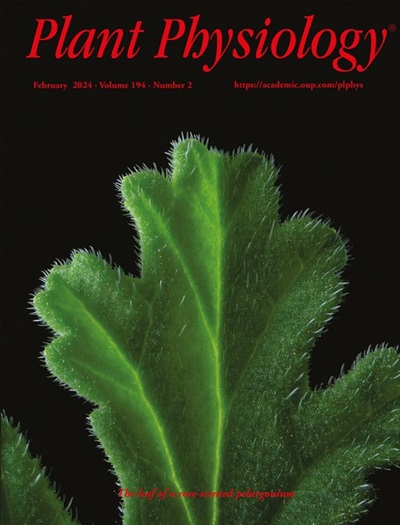Stomatal closure as a driver of minimum leaf conductance declines at high temperature and vapor pressure deficit in Quercus.
IF 6.5
1区 生物学
Q1 PLANT SCIENCES
引用次数: 0
Abstract
Rising global temperatures and vapor pressure deficits (VPD) are increasing plant water demand and becoming major drivers of large-scale plant mortality. Controlling transient leaf water loss after stomatal closure (gmin) is recognized as a key trait determining how long plants survive during soil drought. Yet, substantial uncertainty remains regarding how gmin responds to elevated temperatures and VPD and the underlying mechanisms. We measured gmin in 24 Quercus species from temperate and Mediterranean climates to determine if gmin was sensitive to a coupled temperature and VPD increase. We also explored mechanistic links to phenology, climate, evolutionary history, and leaf anatomy. We found that gmin in all species exhibited a non-linear negative temperature and VPD dependence. At 25°C (VPD = 2.2 kPa), gmin varied from 1.19 to 8.09 mmol m-2 s-1 across species but converged to 0.57 ± 0.06 mmol m-2 s-1 at 45°C (VPD = 6.6 kPa). In a subset of species, the effect of temperature and VPD on gmin was reversible and linked to the degree of stomatal closure, which was greater at 45°C than at 25°C. Our results show that gmin is dependent on temperature and VPD, is highly conserved in Quercus species, and is linked to leaf anatomy and stomatal behavior.气孔关闭是柞树在高温和蒸汽压力不足条件下叶片最小传导率下降的驱动因素。
全球气温升高和蒸气压不足(VPD)正在增加植物的需水量,并成为植物大规模死亡的主要原因。控制气孔关闭后的瞬时叶片失水(gmin)被认为是决定植物在土壤干旱中存活多长时间的关键特征。然而,关于 gmin 对温度升高和 VPD 的反应及其内在机制,仍然存在很大的不确定性。我们测量了温带和地中海气候条件下 24 种柞树的 gmin,以确定 gmin 是否对温度和 VPD 上升的耦合效应敏感。我们还探讨了与物候、气候、进化史和叶片解剖学之间的机理联系。我们发现,所有物种的 gmin 都与温度和 VPD 呈非线性负相关。在 25°C(VPD = 2.2 kPa)时,各物种的 gmin 变化范围为 1.19 至 8.09 mmol m-2 s-1,但在 45°C(VPD = 6.6 kPa)时,gmin 趋近于 0.57 ± 0.06 mmol m-2 s-1。在一部分物种中,温度和 VPD 对 gmin 的影响是可逆的,并且与气孔关闭程度有关,45°C 时气孔关闭程度大于 25°C。我们的研究结果表明,gmin依赖于温度和VPD,在柞树物种中高度保守,并且与叶片解剖和气孔行为有关。
本文章由计算机程序翻译,如有差异,请以英文原文为准。
求助全文
约1分钟内获得全文
求助全文
来源期刊

Plant Physiology
生物-植物科学
CiteScore
12.20
自引率
5.40%
发文量
535
审稿时长
2.3 months
期刊介绍:
Plant Physiology® is a distinguished and highly respected journal with a rich history dating back to its establishment in 1926. It stands as a leading international publication in the field of plant biology, covering a comprehensive range of topics from the molecular and structural aspects of plant life to systems biology and ecophysiology. Recognized as the most highly cited journal in plant sciences, Plant Physiology® is a testament to its commitment to excellence and the dissemination of groundbreaking research.
As the official publication of the American Society of Plant Biologists, Plant Physiology® upholds rigorous peer-review standards, ensuring that the scientific community receives the highest quality research. The journal releases 12 issues annually, providing a steady stream of new findings and insights to its readership.
 求助内容:
求助内容: 应助结果提醒方式:
应助结果提醒方式:


